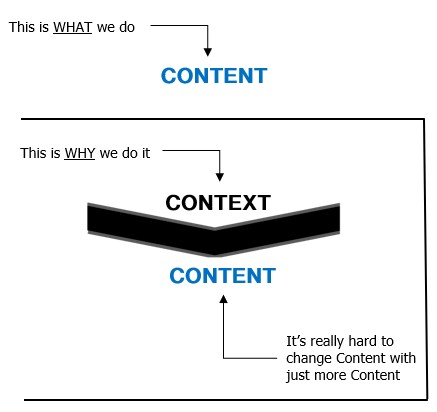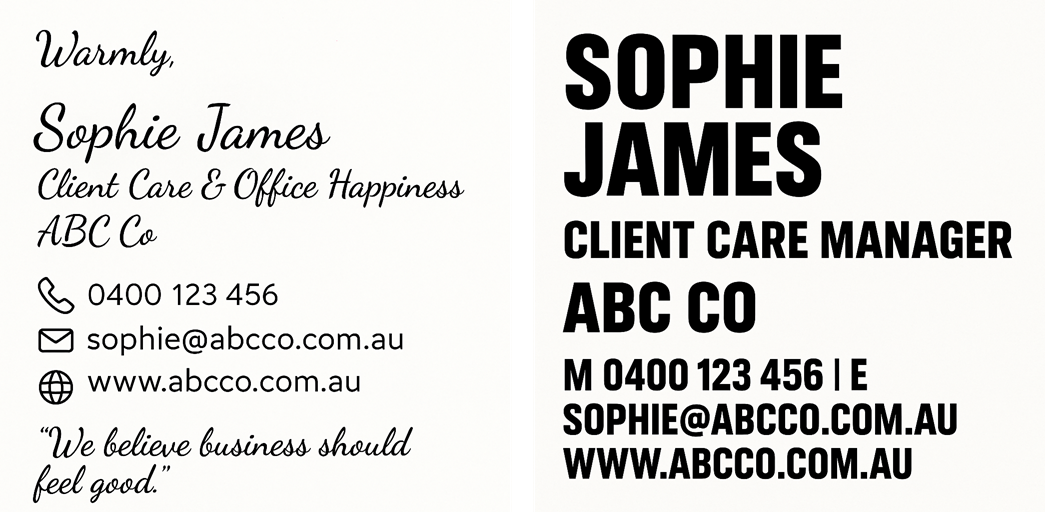Everything that happens in your law firm can be traced back to a decision you made some time in the past. That decision was the source of the outcome you experienced – a common example is a HR problem because you rushed a recruitment decision.
When you made that decision there was a reason behind it. That reason is what we call the context of the decision – for example, prioritising short-term cash flow needs over long-term culture.
As a leader you make clear, consistent, and confident decisions when you know your context at each layer of your law firm. Once you have decided on your context, then you can communicate it to your legal and administrative staff, who will be able to apply that context themselves and make the correct decisions without requiring your approval.
Introducing Context
Context provides clarity for making decisions. At Como Legal Coaching, we use the Context framework when Partners find themselves unclear of which choice to make, or when Teams begin diving into the detail and execution. Context provides an anchor and refocuses you and your team on your highest commercial and cultural objectives. Context also allows faster processing of information, giving you more headspace in which to consider a decision.
Whenever you hear people say:
- I’m confused
- I’m overwhelmed
- We can’t choose
- There’s too much detail for me to process.
that’s a good indication your team are stuck in the day-to-day content without the overarching context to guide their activity.
Content versus Context | Content and Context
Most of our actions – the things we do and plans we create as a result of the decisions we make – can be referred to as “Content”. Content is the ongoing, everyday stuff: “what” we do, and “how” we do it.
Your ToDo List is Content. Your Inbox is Content. Your CPD requirements are Content. And you can’t solve the problem of too much content by adding more content.
Most law firm owners we speak to are stuffed. Metaphorically, they’re worn out; but quite literally their days and weeks are stuffed with ‘content’.
One of the realities of being a business owner is that the longer you’re in business – the more team, the more clients, and even the more money that you’re bringing in – the more stuffed you get.
The Context Framework is about helping you to get unstuffed. Understanding how to apply Context gives you the helicopter ‘big picture’ view that is sometimes hard to find in a business. Most importantly, Context is the only tool that can reduce your Content load, so you work less in the business and start working more on the business.

Are you clear about the Context that sits around all the decisions made within your law firm?
In this article we introduce the simple concept of Context. You may also enjoy our separate article on The 5 Layers of Context in a Law Firm, to help further bring to your awareness the decisions you are making around vision, strategy, resource allocation and more.
Applying Context as a Leader
Context gives meaning to the content. Most problems in legal businesses stem from the fact that there is normally plenty of content, but no context and therefore no meaning or direction.
When you provide context to your team you are providing meaning for their activity. As you will see if you read more of our articles, watch our videos, or work with us – this can be meaning at a task level (“In this conversation I need you to make a decision”) all the way up to your highest context (“I am allocating 20% of our resources to Legal Aid because ensuring legal access is why we are in business”).
Commercially, giving clear direction has benefits for your business’s efficiency. Culturally, when you are communicating at a context level you will feel calmer, clearer, and more focussed and connected to your business.
Being able to operate in Context is a key skill in learning how to coach and manage your business.
A Context Case Study: The Professional Email Signature
Early in Jacob’s coaching career, his team worked with a small professional services firm – a dozen employees, mostly professional staff with a sole director. Here is Jacob’s story about Context:
We began our engagement with a strategic business review, where we talk 1-on-1 with every member of the team. It was clear the culture was divided, and this was a specific story we heard multiple times.
This was at a time when giving each team member their own email address was new, and the owner had the smart idea to create a consistent signature block for every team member – standard today, but novel twenty years ago.
He asked two team members to come up with a design each. The first was very flowing, cursive writing; the second was strong, block letters.

The owner looked at them both, said thanks, and promptly decided on the second one.
How did the winning designer feel? Great! And how did his friends in the office respond? “Great choice boss.”
How did the losing designer feel? Less great, like she had wasted her time on the task. And her friends in the office? They were quick to tell her the boss had made the wrong choice.
This decision-making process, focussed on the content and dependent on the owner, created one competition with a winner and a loser, and ongoing workplace division.
Then the Owner Changed His Mind
Within a few weeks of implementing his decision, the owner started collecting negative feedback about the signature block. Clients and referrers were telling him it didn’t feel right, it didn’t represent his firm.
So the owner called his team back together … and announced that he had changed his mind, the block letters were out, the cursive writing was in.
Now how did the block letter designer feel? And the cursive designer? Workplace harmony?
What had happened was that the owner had made decisions, several of them, without ever communicating the purpose for those decisions. The email design was the content but the owner had set no context for the task.
There WAS a Context, but Nobody Knew It
While the owner hadn’t set a context, one did exist. There was a purpose – he just wasn’t clear on it himself, so couldn’t communicate it with his team.

My coaching team recommended several strategic projects for this firm, including one about their Brand Promise. Our strategic business review made it clear they were not projecting a consistent message to their target clients and referrers, which was holding them back commercially.
We interviewed their clients, referrers, and suppliers to understand what made them special – and one word that kept being repeated, and which then formed the basis of their Brand Promise, was ‘Friendly‘. Clients liked working with the owner and his firm because it was so friendly to deal with.
“Friendly” was the context for the Brand and Marketing. Now, if the owner had been aware that he was building a friendly firm back at the beginning, how would the email signature exercise have been different?
Outcome #1: He would have chosen the friendly, cursive design over the block letters.
Outcome #2: In fact, he probably never would have seen the block letters – each team members would have brought him a ‘friendly’ design option.
Outcome #3: Actually, there wouldn’t be two competing designs at all – he would have asked the two staff members to work together to create one, friendly option.
Had the Owner applied the Context framework there would have been less content to deal with. And instead of dividing his office and creating workplace politics, he would have had a happier – and friendlier – workplace.

Wasting Valuable Time in the Content
This case study is something we see, contextually, play out in almost every law firm we review. The content varies, but the problem remains the same – differences of opinions or preference that lead to endless debates about which option is better in the content:
- Style guide choices
- File name conventions
- Precedent flexibility
- Choice of practice management software
- Application of AI tools
You can start making a different choice immediately.
How and When to Apply Context in a Law Firm
The Context framework can be used in a variety of situations, for example:
- Getting to the ‘heart’ of the problem – i.e. what is this really all about?
- Explaining the “Why” of a decision to your employees / colleagues
- Providing the big picture in a simple way so that you can delegate tasks (and with confidence that the correct decision will be made)
- Setting and managing an agenda for a meeting – find and agree/communicate the Context for the meeting, rather than simply focusing on the Content of the agenda
- Presentations – what is the overall message you want to convey from this presentation
- Conversations – to put meaning around the material
There are enormous benefits of being aware of your context, and communicating it with others. In law firms, this includes increased speed of communication and understanding, improved vision setting and strategic planning, and decreased emotion and frustration around decision-making by agreeing context before deciding content.
While context is among the most powerful tools we gift our clients, it’s also one of the easiest to apply. You’ll notice we use the diagram of the arrow – showing context giving meaning to the content.

In your mind and in your notes, the arrow is your prompt to ask yourself “Why?”
Why am I making this decision? For what purpose are we executing this strategy, or making these changes?
Being clear on this reason, the context, makes your decision easier and provides clarity when communicating it with your team.
If you are stuck, you can use the different layers to help identify where you are (for example, making a Resources decision), and chunk up to where you are seeking contextual clarity (for example, connecting with a Strategy). This can focus your question.
Or you might need a specific Contextual Framework to help bring clarity. These are the tools that Como Legal Coaching uses with our law firm clients, to shift from content to context. Many of them are outlined in this video series.
Alternatively, just keep asking “Why?”, writing these reasons above each other. You may end up with more, or less, layers than we use. But once you align your immediate choice with a higher context, clarity is created and time is saved. You have reduced your content load by not having more content.
Why We Are Contextual Business Coaches
At Como Legal Coaching we are happy to roll up our sleeves and dive into your content, often in a consulting capacity (‘fix it for you’) not just as coaches. In our Tranformation clients, for example we want to increase revenue significantly in the first 90 days and that often requires new bespoke productivity systems.
We also know that long term sustainability – especially when our coaching engagement ends – relies on our law firm owner clients to understand their context for business and the changes being made.
Como Legal Coaching was founded as a contextual coaching company. Harmony and Jacob are in an exclusive group of 100 practicing coaches worldwide who have received the combined training and mentoring for how to apply Context as both an Individual and a Business.
Bringing this combination to law firm partners is our core value and point of difference in a market crowded by coaches and advisors who can only bring you more content.
Stopping to ask yourself ‘Why’ is a simple task to bring into your every day life. We work with female-led law firms who have 10 to 50 employees, and want transformation to do law, life, and business their way. Contact Us to learn more.

